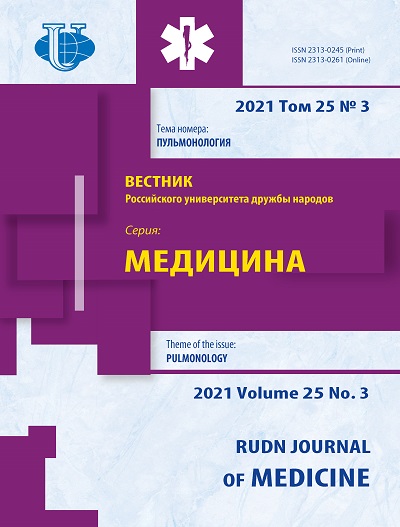Cardiovascular risk factors in rural areas: case of the Mabayi health district hospital in Burundi
- Authors: Ndirahisha E.1, Barasukana P.1, Nyandwi J.1, Manirakiza S.1, Nyandwi R.1, Baransaka E.1
-
Affiliations:
- University of Burundi
- Issue: Vol 25, No 3 (2021): PULMONOLOGY
- Pages: 229-234
- Section: SOCIAL HEALTH AND HEALTH PROTECTION
- URL: https://journals.rudn.ru/medicine/article/view/27539
- DOI: https://doi.org/10.22363/2313-0245-2021-25-3-229-234
Cite item
Full Text
Abstract
Relevance . Noncommunicable diseases are a serious public health problem due to their high incidence and mortality rate. Globally, noncommunicable diseases cause 41 million deaths every year, accounting for 71% of the total number of deaths. Cardiovascular diseases, accounting for 44% of all noncommunicable diseases, are the leading causes of death. Early identification of the main risk factors for cardiovascular diseases and treatment of associated diseases are a prerequisite for maintaining the health of the population. Objective: To identify the main risk factors for cardiovascular disease in patients living in rural areas of the mountainous region and attending the Mabayi District Hospital in Burundi. Patients and Methods . An open-label retrospective study conducted at the Mabayi District Hospital in Burundi from January 2014 to December 2017. The study included patients whose medical examination revealed at least one risk factor for cardiovascular diseases. The study was approved by the ethics committee of the Kamenge University Hospital and the Faculty of Medicine of the University of Burundi. Data analysis was carried out using Microsoft Word 2007 and Epi-Info TM 7.2.1.0 software. Results and Discussion . Among the 20 297 examined patients, the average age was 50 ± 16.7 years, the extreme values were 14 and 101 years. Male patients accounted for 51.1%. 903 patients (4.5%) had at least one risk factor. The main risk factors were high blood pressure (52.6%), diabetes (42.0%) and alcohol abuse (27.4%). Conclusion . Residents of rural areas of the mountainous region of Burundi have a high frequency of risk factors for cardiovascular diseases, which must be taken into account when organizing medical and preventive measures to prevent cardiovascular diseases.
Keywords
About the authors
Eugène Ndirahisha
University of Burundi
Author for correspondence.
Email: kabandaeugene@yahoo.fr
ORCID iD: 0000-0003-3243-1967
Bujumbura, Burundi
Patrice Barasukana
University of Burundi
Email: kabandaeugene@yahoo.fr
Bujumbura, Burundi
Joseph Nyandwi
University of Burundi
Email: kabandaeugene@yahoo.fr
ORCID iD: 0000-0002-3715-7891
Bujumbura, Burundi
Sébastien Manirakiza
University of Burundi
Email: kabandaeugene@yahoo.fr
Bujumbura, Burundi
Rhamadhan Nyandwi
University of Burundi
Email: kabandaeugene@yahoo.fr
ORCID iD: 0000-0003-4371-425X
Bujumbura, Burundi
Elysée Baransaka
University of Burundi
Email: kabandaeugene@yahoo.fr
ORCID iD: 0000-0002-7796-6626
Bujumbura, Burundi
References
- World Health Organization. Noncommunicable diseases. Key facts. 2021. https://www.who.int/news-room/fact-sheets/detail/ noncommunicable-diseases. (Accessed January 10, 2021)
- World Health Organization. The top 10 causes of death. WHO Media Centre: The top 10 causes of death. 2017. (Accessed January 10, 2021)
- Boutayeb A et al. The double burden of communicable and non-communicable diseases in developing countries. Tropical Medicine and Hygiene. 2006;100:191-9.
- Rguibi M and Belahcen R. Prevalence of obesity in Morocco. Obesity reviews. 2007;8:11-3.
- Chobanian AV, Bakris GL, Black HR et al. The seventh report of the joint national committee on prevention, detection. Evaluation and treatment of high blood pressure. The JNC7 report. JAMA. 2003;289:2560-72.
- Chiche F, Giral P et al. Prise en charge des patients dyslipidémiques. Annales d’endocrinologie. 2009;70:119-125.
- Branca F, Nikogosian H, Lobstein T. The challenge of obesity in the WHO European Region and strategies for response. British medical journal. 2007;13:34-41.
- Lucidarme N, Domingues- Muriel E. Report of the expert committee on the diagnosis and classification of diabetes mellitus. Diabetes Care. 2007;20:1183-97.
- Bernstein MS, Morabia A, Sloutskis D. Definition and prevalence of sedentary in an urban population. Am J Public Health. 1999;89:862-867.
- Rudaz A, Rima A, Humair JP. Scores de risqué cardiovasculaire: pourquoi, comment et quand les utiliser? Rev Med Suisse. 2010;6:1809- 1815.
- OMS/Comité régional de l’Afrique. Les maladies cardiovasculaires dans la région Africaine: Situation actuelle et perspectives. AFR/RC55/12;17 juin 2005.
- Ghazi El, Berni I, Menouni A, Kestemont MP, Amane M, Jaafari ES. Profil épidémiologique des maladies cardiovasculaires dans la ville de Meknès (Maroc). Eur Sc journal. 2018;14 (33):49-55.
- Finegold JA, Asaria P, Francis DP. Mortality from ischaemic heart disease by country, region, and age: statics from world Health Organization and United Nations. International Journal of Cardiology. 2012;168 (2): 934-945.
- Fourcade L, Paule P, Mafart B. Hypertension artérielle en Afrique subsaharienne: Actualité et perspectives. Med trop. 2007;67: 559-567.
- Prevention of Cardiovascular Disease: Guidelines for Assessment and Management of Cardiovascular Risk. WHO. 2007. ISBN978-92-4-154717-8. (Accessed January 10, 2021)
















